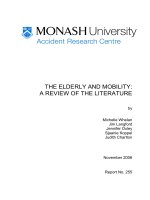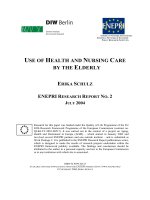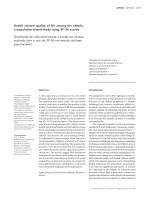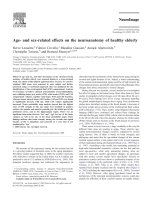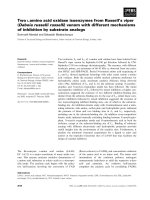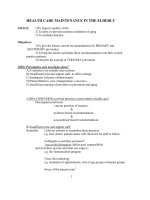The use of technology by the elderly pdf
Bạn đang xem bản rút gọn của tài liệu. Xem và tải ngay bản đầy đủ của tài liệu tại đây (399.06 KB, 9 trang )
HEALTH SCIENCE JOURNAL ® VOLUME 4, ISSUE 2 (2010)
The use of technology by the elderly 118
pp:118-126
E-ISSN:1791-809X www.hsj.gr
Health Science Journal® All Rights Reserved
The use of technology by the elderly
Zoe Roupa,
1
Marios Νikas,
2
Εlena Gerasimou,
3
Vasiliki Zafeiri,
4
Lamprini Giasyrani,
5
Eunomia
Κazitori,
6
Pinelopi Sotiropoulou.
7
1. Professor in Nursing Department, Technological and Educational Institute of Larissa,
2. MSc, Community Nurse,
3. Graduate of Nursing Department A’ TEI of Athens,
4. Ph.D., Dentist,
5. R.N.,
6. MSc, R.N., General Hospital "Geniko Kratiko Nikaias" Hospital,
7. MSc, Health Visitor Nurse, “Sotiria” Hospital.
Abstract
The use of technology and its’ providing information allows the elderly to face more easily the
difficulties of modern life, trespassing the limits of their social and emotional isolation, thus
achieving a more qualitative living.
The purpose of this research was to explore whether the elderly were familiar with modern
technology.
Material and Method: The sample studied consisted of 300 people, 65-85 years old. Collection of
data was conducted by the completion of an anonymous questionnaire. Analysis of data was
performed using the SPSS 15 statistical package and one-way ANOVA x
2
-test, and t-tests were
applied for the statistical process.
Results: Οf the 300 individuals studied, 134 were men and 166 women. 79.7% were in the age
group of 65 to 74 years. All respondents reported that they used everyday appliances. In detail,
94% of women used machines that help in household tasks such as washing machines, 98.5% iron,
whereas the 98.8% of men preferred watching television. Regarding the use of ATM machines,
women faced more difficulties with a statistical significant difference, compared to men,
p<0,001. On the contrary, 93.37% of women handled mobile phones almost satisfactorily
compared to men, p<0,001. Both sexes, however, preferred the hearing headset, 72.93% women
and 89.76% men, when facing hearing difficulties.
Conclusions: Aging is a normal procedure in which deduction in all biological and mental
functions takes place, leading to exhaustion and losing patience. Older people constantly face
with the challenges of contemporary reality, as the ever-evolving technology. For this reason,
they need appropriate support and guidance in order to satisfactorily meet with the difficulties
of everyday living.
Keywords: elderly people, technology, electronic devices, quality of life
Corresponding author:
Zoe Roupa, Aigosthenon 86, Galatsi, 11146,
Tel: 210 2931022, mobile 6974780723,
E-mail:
HEALTH SCIENCE JOURNAL ® VOLUME 4, ISSUE 2 (2010)
The use of technology by the elderly 119
pp:118-126
E-ISSN:1791-809X www.hsj.gr
Health Science Journal® All Rights Reserved
Introduction
n the rapidly aging population, the elderly
are called upon to adapt to new
technology and the demands of modern
society. It is widely accepted that elder
individuals show low adjustment to the
advent of new technologies compared to
younger generations, either because they do
not have the technological experience or
because of their current health status
1,2,3
.
Furthermore, at their effort to use
new technologies, they usually face many
difficulties deriving from demographic
characteristics such as income, education,
geographical location, possible disabilities,
as well as difficulties related to the
complexity of new technology. Other
contributing factors for this low adjustment
to new technologies are the lack of
incentives, economical obstacles, digital
skills and appropriate training. A commonly
held view is that the market is not currently
investing enough on innovations for the elder
users, such as comprehensive and user-
friendly services for healthier living
conditions. In addition, many products and
services often are not appropriate to the
needs of elder users, exacerbating the sense
of frustration and leading to dependence on
other people
3,4,5
.
The main sources of information for
the elderly is the Internet, thematic
television channels and magazines. In their
effort to take greater responsibility for their
personal health, physical status and
independent living conditions, the elderly
users need to be more informed through the
use of Internet, thematic television
channels, magazines and other sources of
information
6,7
.
Technology may involve the use of
most simple everyday electrical appliances
(TV, kitchen, vacuum cleaner, dishwasher,
etc.) or other more complex machines
(ATMs, PCs, mobile phones etc.) premising
the ability to properly use them.
In is widely accepted the use of new
technology by the elderly population has a
beneficial effect on their quality of life. It is
an essential step if the younger help them
to familiarize with technology, thus removing
all fears of new technology use.
Furthermore, understanding the difficulties
that the elderly experience should prompt
health professionals to provide adequate
information that will significantly contribute
to the improvement of their quality of
life
8,9,10
.
It seems very important, that the
state could contribute to the elderly’ s
adaptation in new technology, as they may
organize a publicity campaign (leaflets with
instructions, spots, etc.) in order to raise
public awareness.
Material and Method
The sample of this research consisted of
300 people (134 men and 166 women) aged
65-85 + years from the geographical divisions
of Macedonia, Thessaly, Central Greece,
Attica and the Peloponnese. The sample has
been taken in accordance to the rules of
random sampling, by personal interview of
the researcher, visiting Open Centers of
Protection for the Elderly.
At first, a preliminary study (pilot
study) was conducted in 30 subjects, by
using all necessary parameters, as well as all
specialized techniques and tests for the
analysis of the data collected.
Data were collected by the
completion of a questionnaire, consisted of
26 items related to the demographic
characteristics, the use of technology and
the health of the participants. The
questionnaire included closed and open-
ended questions, and was completed by
personal interview of the researcher, after
having given the necessary information,
clearly explained the objectives of the
survey and ensured anonymity of the
respondents. The completion of the
questionnaires lasted from August to October
2007.
Statistical Program for Social Sciences
SPSS 15 was used for the statistical
processing of the data. The chi
‐squared test
was used for testing the hypothesis of
I
HEALTH SCIENCE JOURNAL ® VOLUME 4, ISSUE 2 (2010)
The use of technology by the elderly 120
pp:118-126
E-ISSN:1791-809X www.hsj.gr
Health Science Journal® All Rights Reserved
independence between two variables, as
well as for testing the homogeneity of
distribution for two categorical variables.
Whenever the above test was not applicable
(expected frequencies of less than 5), the
Fisher exact text was used. Cronbach’s
alpha, showing the internal consistency of
scale, is a=0,9027. The Anova and the t-test
were used for testing equality of means for
more than two or less than two groups
respectively.
All tests are significant when the
p
‐value is less than 0.05. For the graphical
display of data, frequency graphs and
percentages were used, such as histograms,
pies and statistical tables.
Results
Of the 300 participants, 79.7% women
and 71.08% of men aged 65 to 74 years.
Women, 6.77%, were the highest percentage
in the upper age group (>85 years) compared
with men, 1.81%. (Figure :1)
In regard to the use of electrical
device by gender, 94% of women used
washing machine, 67% vacuum cleaner,
87.2% electric iron, 98.5% with electric stove
and 54% wireless phone. Almost all the
respondents answered that they were able to
handle the TV. (Figure :2) More in detail,
compared to men, women were more
familiar to the use of washing machine,
vacuum cleaner, electric iron, electric stove,
with statistical significant difference,
p<0,001.
In regard to ATM (automatic teller
machines), 28.4% of the participants
reported that they “always” used ATMs
(approximately 85 people in the study),
“sometimes” 39.2%, “rarely” 28.4% and “do
not ever use” ATMs, 4%. (Table :1). More in
detail, regarding the frequency of use ATM
in relation to sex, 49.6% of women and
11.4% reported that they never used ATM,
27.0% of women AND 48.8% of men reported
that they used ATM rarely, whereas 22.5% of
women and 33.1% of men reported that they
used ATM sometimes an never 0,7% of
women and 6,6% of men. (Fig: 3).
78.3% of the participants used mobile
phones. More in detail, regarding the use of
mobile phones in relation to Sex, 40.6% of
the women and 6.6% of men did not use
mobile phone, whereas 59.4% of women and
93.3% of men used mobile phone. (Fig: 4).
In regard to the use of hearing aids,
72.93% of women and 89.76% of men did not
use it, whereas 27.07% of women and 10.24%
of men used hearing aids. (Fig: 5).
Discussion
This research, studied the ability of
the elderly to meet with the rapidly
advancing technology and mainly the use of
everyday appliances and devices, such as
household appliances, mobile phones,
banking machines and auxiliary hearing aids
if the elderly experienced hearing problems.
According to the results the average
age of women, in all three age groups, was
higher compared to men. One possible
interpretation is that women develop greater
life expectancy than men, following the
general trend worldwide, and seem to
outnumber men. According to a report
published by the G.S.V.E.E. in 2003, life
expectancy in Greece stood at 76.5 years for
men and 81.3 years for women
11
.
Very important are the findings,
about the proportion of elderly people who
use electronic household appliances. Thus, in
their daily lives, the elder individuals used
appliances such as washing machines,
electrical kitchen, wireless phones, vacuum
cleaner, iron and the overwhelming majority
used television. Interestingly, however, is
that in all cases, women used these devices
in a greater proportion than men, who only
show elevated rates in using the television,
compared to women.
A similar survey conducted by the
National Statistical Service of Britain, from
1998 to 2001, at a national level, among
people aged 65 and older, showed that
elderly people used largely household
appliances
12
. Specifically, the use of
electrical kitchen and oven from 65% in 1998,
rose to 75% by 2001, the use of TV from 13%
to 23% in 2001, while the elderly in Britain
HEALTH SCIENCE JOURNAL ® VOLUME 4, ISSUE 2 (2010)
The use of technology by the elderly 121
pp:118-126
E-ISSN:1791-809X www.hsj.gr
Health Science Journal® All Rights Reserved
are aware of and able to use computers and
the Internet in a proportion of 14%.
An additional survey that was
conducted in New Zealand by Alison Robins
13
,
indicated that the majority of the elder
citizens enjoyed at a high rate almost all
domestic facilities, provided by electrical
devices. More in detail, 93% of the
participants were able to handle TV, 87%
washing machine and dryer, 99% high
technology refrigerators and 94% to use
wireless phones.
Similar to the present findings, the
results of the by the Statistical Office of
Finland showed that 30% of the elderly
women used washing machines, whereas 7%
of men used these electrical devices
14
.
According to the results of the
present study few participants used ATM
machines. A possible explanation is that the
elder individuals, having not been familiar
with new technology, are frequently
discouraged at their effort to use ATM due to
the difficulties they face such as handling
the keyboard, fear, ignorance, screen
problems.
The results of the present study are
similar to those by Arsenos at al.,
15
who
showed that 57.8% of the elder participants
living in Athens had not ever used the ATMs
and consequently they ignored the services
and opportunities provided by the machines
of this type. On the contrary, 5.9% of
participants reported that they were aware
of all the services and capabilities of ATMs.
The reasons to avoid using ATMs were the
difficulty of handling the keyboard, the lack
of knowledge about their operations and the
fear of being robbed during the transaction.
Similarly, in Netherlands, Mollenkopf
et al.,
16
showed that only a small percentage
of the elderly used the ATMs because all the
other found it difficult to adjust to new
technology and generally to the use of new
devices. However, those who used them,
reported quite satisfied and found out that
technology facilitated their lives.
Very interesting are the findings
concerning the familiarity of participants to
mobile phones. More in detail, elderly men
(93.4%) used them more often than women
(59.4%). Interestingly, knowledge of mobile
use is limited in achieving calls and in some
cases, sending short messages. There is no
extensive use of services and opportunities
offered by mobile phones.
In Japan, Hata et al.,
17
showed that
among Japanese women, aged 70-89 years,
only 10% where using mobile phones,
whereas 60% of the participants showed
interest in learning how to use a mobile
phone. Thus, researchers concluded that the
design of a type of keyboard combining the
features of a touch screen and a dictionary
could be highly beneficial for the elderly.
Furthermore, the survey conducted, by
Shizuka et al.,
18
in Japan, showed that 37.8%
of individuals aged 60-69 years and 19.1%
aged 70 to 80 years used mobile phones
Interesting also are the results by
Salmon et al.,
19
who studied whether
individuals with Alzheimer in Belgium were
able to use mobile phones. This study
showed that after 2 sessions about the use of
mobile phone, two patients learned properly
to use it. This study highlights the efficacy of
coordinated and organized efforts for patient
autonomy.
According the difference between
sexes and the use of mobile phones, there is
a study conducted by Sri Kurniawan,
20
the
United Kingdom, showed that women were
those who make more and often
indiscriminate use of mobile phones,
especially those of age 65 to 74 years, at a
percentage of 60%, while those aged 75 years
and older, 36%. A research carried out in
Malaysia, among 176 senior citizens, by Mohr
Hairum Nizam et al.,
21
concluded that
elderly people are able to use mobile
phones, especially men use them at a rate 60
%.
From all the above, is easily seen that
in countries where technology is highly
developed, such as Asian countries, the
elderly are more familiar with the use of
advanced phones, compared to elderly
people living in countries where technology
is in early stages and is under development.
Important are also the findings
related to elderly people with hearing
problems. Thus, 82.3% of elderly people do
HEALTH SCIENCE JOURNAL ® VOLUME 4, ISSUE 2 (2010)
The use of technology by the elderly 122
pp:118-126
E-ISSN:1791-809X www.hsj.gr
Health Science Journal® All Rights Reserved
not use hearing aids. The percentage of
women who used hearing headsets was
higher compared to men. In a survey
conducted in Kuopio, Finland, in March 2005,
related to the percentage of avoiding the
use of hearing aids, among the elderly over
75 years, Lupsakko et al.,
22
concluded that
13-15% of older people with hearing
problems, have held hearing headsets. But
most of them did not use them, either
because they could not understand how they
work, or because it was not the perfect
device to have chosen, in shape and size.
It is worth noting, that the hearing
aids cannot be used by people with
intellectual disabilities and concluded that
the use of hearing aids by persons with
disabilities can lead to incorrect use,
therefore, these people should be monitored
and receive special treatment from qualified
people.
Regarding hearing headsets, Fletcher et
al.,
23
studied elderly people who had
problems with their hearing related to use of
hearing aids. The researchers collected
personal information for 32.656 individuals
and gave the opportunity to 78% (14.877) of
them to do an acoustic test. It was found
that 8% participants (2537), showed great
difficulty in listening and 46% failed in
acoustic tests. More than half of people who
failed the test had no special equipment,
while 60% of the participants who wore
hearing aids, stated that they use them
regularly. The level of use of hearing devices
were in perfect line with the level of
perception of the elderly.
From the results of the present study,
it is evident that the use of new technologies
by the elderly population significantly
contributes to a better quality of life,
improving parameters of daily living such as
transportation facilitation, communication
and participation in social life. Further, it
offers the link of elderly to services that
meet their immediate needs, and in
particular the cooperation and coordination
with the network of Primary Care and Social
Protection.
Conclusion
Education of the untrained elderly is
the most essential step in order to become
familiar with new technologies. More in
detail, this can be accomplished through
specifically designed education programs
that teach elderly the way new technologies
work.
Furthermore, these programs should
be also addressed to individuals who belong
to the supportive environment of the elderly
such as the younger members of the family.
It would be beneficial if the younger helped
them to familiarize with each object,
removing fears of using high technology
devices.
Bibliography
1. Kontaxakis B.P, Christodoulou G.N. Third
Age People. Ed. Beta, Athens, 2000.
2. McKenzie B., Cambell J. Race,
socioeconomic and the subjective well-
being of older Americans. Int J Aging
Hum Dev.1987;25(1):43-61.
3. Cutler D.M., Meara E. Changes in the age
distribution of mortality over the 20
th
Century. NBER Working Paper No 8556,
October 2001.
4. Malgarinou M., Goulia E. The nurse close
the elderly. Ed. Tavitha, 4th edition,
Athens, 1997.
5.
Εmke-Poulopoulou I. Greek elderly
citizens. Past, Present and Future. Ed
Ellin, Athens, 1999.
6. Kouroupetroglou G., Nemeth G. Speech
Technology for Disabled and Elderly
People, chapter in the book
"Telecommunications for All". Ed. Patrick
Roe, Published by the European
Commission - Directorate General XIII,
Catalogue number: CD-90-95-712-EN-C,
1995, pp.186-195.
7. Kouroupetroglou G., Mitsopoulos E.
Speech-enabled e-Commerce for Disabled
and Elderly Persons, Proceedings of the
COST219 Seminar Speech and Hearing
Technology, Cottbus, Germany, 2000.
8. Richard D., Gross, Rob Mc Queen:
Adolescence, Adulthood and old age.
Hobber Education, 1999.
HEALTH SCIENCE JOURNAL ® VOLUME 4, ISSUE 2 (2010)
The use of technology by the elderly 123
pp:118-126
E-ISSN:1791-809X www.hsj.gr
Health Science Journal® All Rights Reserved
9. Posner R. Aging and old age. The
University of Chicago Press, London,
1995.
10. Polychronopoulos P. Philosophy of
Technology. Ed Ellin, 1st edition, Athens,
2002.
11. G.S.V.E.E: Instruction of National
Strategy for Social Protection and Social
Inclusion 2008-2010, Social Protection
Posts, Athens, 2008.
12. National Statistics: Living in Britain 2001.
Housing and consumer durables. Clinical
Gerontology, 2005.
13. Robins A. Household expenditure and
income survey: what can it tell us about
standard of living?. Social Policy Journal
of New Zealand, 1996 - msd.govt.nz
14. Aalto Kr. Who washes the laundry in
Finland?. National Consumer Research
Center, Finland, 2003.
15. Arsenos P., Sapountzi-Krepia D., Roupa
Z., Zafiri V., Nikas M., Darivakis S., et al.
Aspects of money management in elderly
populations.
Ηealth Science Journal.
2007, Vol 1, Issue 1.
16. Mollenkopf H., Marcellini F., Ruoppila I.,
Szeman Z., Tacken M., Oswald F., et al.
The MOBILATE project- enhancing
Outdoor Mobility in Later Life. European
Journal of Aging.2004; Vol 1, Issue 1.
17. Uchida H., Hata Y., Matsurura S., Aoyama
H. An evaluation of use of information
technology equipment among Japanese
elderly women – relation between health
status and the preferred input device for
the Internet. Department of Health
Education, Himeji Institute of
Technology, Shinzaikehoncho, Asia Pac J
Public Health, 2001, Vol 13.
18. Shizuka A. Social benefits of
communication Technologies for aging
Population-A case study of Japan. Asia
Culture Forum, Japan, 2006, session 8.
19. Salmon E., Adam S., Van der Linden M.,
Juilleerat A. The cognitive management
of daily life activities in patients with
mild to moderate Alzheimer’s disease in
a day care center : a case report. Acta
Neurol. 2002;102:114-121.
20. Kurniawan Sri. An explanatory study of
how old women use mobile phones.
Lecture Notes in Computer Science, UK.
2006; 4206:105-122.
21. Mohd Hairul Nizam MD Nasir, Hazrima
Harsan, Nazean Jomhavi. The use of
mobile phones by elderly: a study in
Malaysian Perspectives. Journal of Social
Sciences. 2008;4(2):123-127.
22. Lupsakko TA., Kautiainen HJ., Sulkava
R. The non – use of hearing aids in people
aged 75 years and over in the city of
Kuopio in Finland. Eur Arch
Otorhinolaryngol. 2005;262(3): 165-9.
23. Smeeth L., Fletcher AE., Stirling S.,
Nunes M., Breeze E., Bulpitt CJ., et al.
Reduced hearing , ownership and use of
hearing aids in elderly people in the UK –
The MRC trial of the assessment and
management of older people in the
community: a cross-sectional survey.
Lancet. 2002;359(9316):1466-70.
24. Chatterjee S., Price A. Healthy Living
with Persuasive Technologies.
Framework, Issues and Challenges. J Am
Inform Assoc. 2009;16(2):171-8.
25. Topo P. Technology in everyday life and
care of elderly living at home and
suffering from dementia. Stud Health
Technol Inform. 1998;48:320-3.
26. Wadsworth LA., Johnson CP. Mass Media
and healthy aging. J Nutr Elde.
2008;27(3-4):319-331.
HEALTH SCIENCE JOURNAL ® VOLUME 4, ISSUE 2 (2010)
The use of technology by the elderly 124
pp:118-126
E-ISSN:1791-809X www.hsj.gr
Health Science Journal® All Rights Reserved
Appendix
>8575-8465-74
AGE GROUP
80,0%
60,0%
40,0%
20,0%
0,0%
P
E
R
C
E
N
T
1,81%
27,11%
71,08%
6,77%
13,53%
79,7%
MALE
FEMALE
SEX
Figure 1: Distribution of the sample according to the use of electrical device.
Figure 2 : Use of electrical appliances by gender
HEALTH SCIENCE JOURNAL ® VOLUME 4, ISSUE 2 (2010)
The use of technology by the elderly 125
pp:118-126
E-ISSN:1791-809X www.hsj.gr
Health Science Journal® All Rights Reserved
ΑΤΜ Use Ν %
Allways
85
28,4
Sometimes
117
39,2
Rarely
85
2
8,4
Never
12
4,0
Total 299* 100
Table 1 : Distribution of the sample-studied according to the frequency of ATM Use
ALLWAYSSOMETIMESRARELYNEVER
50,0%
40,0%
30,0%
20,0%
10,0%
0,0%
P
E
R
C
E
N
T
6,63%
33,13%
48,8%
11,45%
0,75%
22,56%
27,07%
49,62%
MALE
FEMALE
SEX
Figure 3 : Distribution of the sample-studied according to ΑΤΜ use in relation to Sex
HEALTH SCIENCE JOURNAL ® VOLUME 4, ISSUE 2 (2010)
The use of technology by the elderly 126
pp:118-126
E-ISSN:1791-809X www.hsj.gr
Health Science Journal® All Rights Reserved
Figure 4 : Distribution of the sample-studied according to Use of Mobile Phones in relation to Sex
Figure 4 : Distribution of the sample-studied according to
Figure 5 : Distribution of the sample-studied according to Use of Hearing Headsets by Sex
YES
NO
100,0%
80,0%
60,0%
40,0%
20,0%
0,0%
Percent
10,24%
89,76%
27,07%
72,93%
MALE
FEMALE
SEX
100,0%
80,0%
60,0%
40,0%
20,0%
0,0%
Percent
93,37%
6,63%
59,4%
40,6%
MALE
FEMALE
SEX
YES
NO
